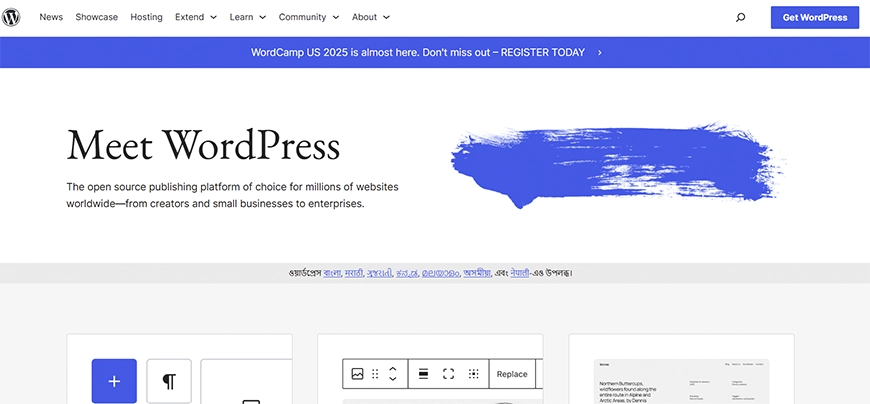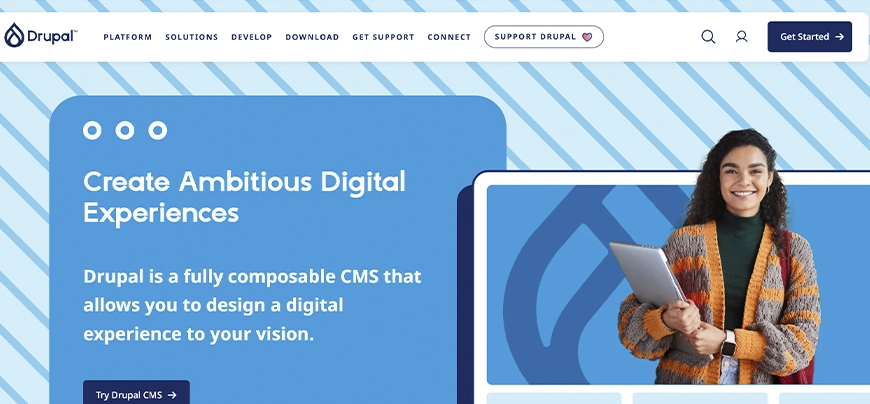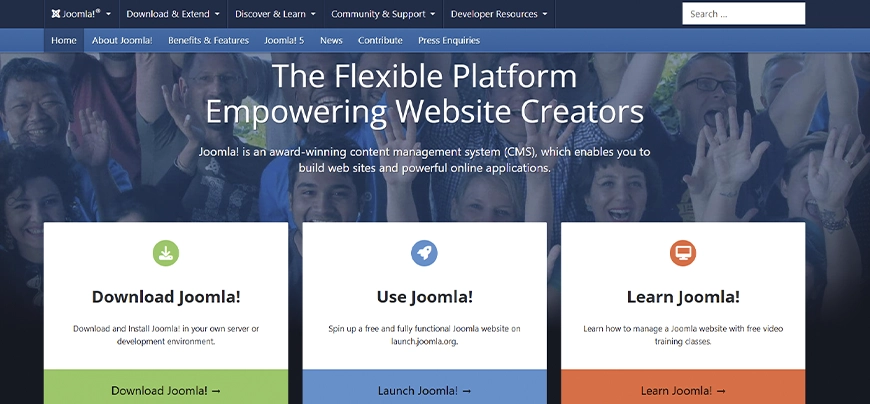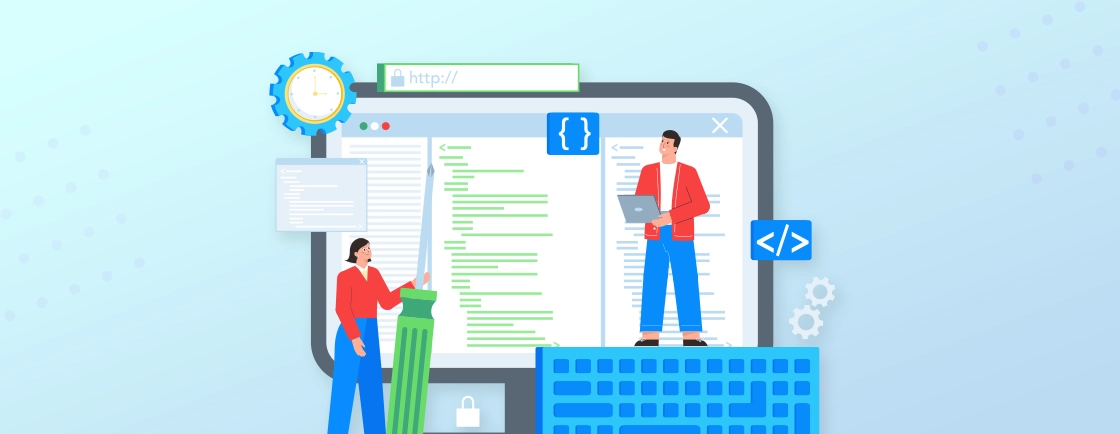Quick Summary
A Content Management System (CMS) simplifies website creation and maintenance by allowing users to publish content without coding. It separates content creation from content delivery and offers features like user roles, easy editing, digital asset management, and collaboration tools. With the right CMS, you can efficiently build, update, and scale a website.
Table of Contents
Imagine if you could build a website without learning coding or dealing with complicated tools. That’s exactly what a Content Management System (CMS) lets you do. It’s like having an easy workspace where you can write content, add pictures, and publish pages, just like working in Microsoft Word or Google Docs.
In web development, a CMS makes things much easier, especially for beginners. You can update your site, add new sections, or share blog posts in minutes. It takes care of the technical work in the background, so you can focus on creating and sharing your content.
But how does a CMS work, what features does it offer, and how do you choose the right one? There are so many questions, but the answer is only one – this comprehensive blog. Let’s discuss these things one by one.
How Does a CMS Work?
A content management system separates two main parts of a website: creating the content and delivering it to visitors. So, you can focus on what you want to share rather than the coding behind it.
It has two main components:
1. Content Management Application (CMA): This is the part you work on. It’s a simple dashboard where you can write articles, upload images, or edit pages without touching any code.
2. Content Delivery Application (CDA): This is the hidden engine. It takes the content you’ve created in the CMA and turns it into a live web page that visitors can see.
Without a CMS, you need to build a website by creating HTML files to structure your content and using CSS to design its look. Then, you need to upload all these files, images, and videos to a web server. This method is possible, but it’s slow, technical, and requires coding knowledge.
A CMS automates all of this. You click “publish,” and the platform instantly handles the HTML, CSS, and hosting work for you. This means even if you’ve never written code, you can still create and manage a fully functional website quickly and efficiently.
Key Features of a CMS
A good CMS is more than just a place to store your website content; it gives you tools to create, organize, and share it easily. Here are the main features you’ll find in popular CMS tools available in the market:
1. User Roles & Permissions
Not everyone who works on a website needs full control over it. A CMS lets you assign specific roles to each user. For example:
- Authors can create and edit their own posts.
- Editors can review and approve content from multiple authors.
- Admins can manage the entire system, including site design and settings.
This role-based access keeps your website secure and organized. It prevents accidental changes, ensures that the right people handle the right tasks, and makes teamwork smoother.
2. Easy Content Creation & Editing
A CMS replaces complicated coding with a simple visual editor. You can add text, images, videos, and links by clicking and typing, no HTML required. Many platforms also allow you:
- Preview your content before publishing.
- Schedule posts for future dates.
- Save drafts to work on later.
This makes it possible to keep your site updated regularly without needing technical skills.
3. Digital Asset Management (DAM)
A CMS includes a media library where you can store and organize all your files: photos, videos, documents, and more in one central location. This means:
- You don’t have to upload the same image every time you use it.
- You can search for assets by name, category, or tag.
- Large teams can reuse brand-approved content to keep messaging consistent.
Some CMS platforms even allow you to set rules, such as where an image can be used or how long a file stays live.
4. Collaboration Tools
If your website involves multiple people (like writers, designers, marketers), a CMS keeps everyone on the same page. CMS platforms offer collaboration features like:
- Content approval workflows so drafts move from writer → editor → publisher in order.
- Commenting and feedback tools so editors can suggest changes without emailing back and forth.
- Version history so you can see what changes were made and restore earlier versions if needed.
This structure prevents miscommunication and ensures deadlines are met.
5. Website Building & Design Tools
Apart from managing content, many CMS platforms help you design your website. You can:
- Start with ready-made templates.
- Customize layouts, colors, and fonts.
- Add components like galleries, forms, or sliders with drag-and-drop tools.
For those who want a custom look, developers can create unique templates or add advanced features through coding while still using the CMS for content updates.
6. Multi-Channel Publishing
Modern CMS platforms can share your content beyond your website. You might publish an article and have it automatically appear on your social media channels, in your email newsletter, or even inside a mobile app. Scheduling tools let you plan campaigns so content goes live at the right time on all platforms.
7. Cloud-Based Access
With a cloud CMS, you’re not tied to one computer. You can log in from home, the office, or your phone to update your site in real-time. This is especially helpful for remote teams or businesses that need to respond quickly to news, sales events, or customer feedback.
By combining these features, a CMS becomes the control center for your online presence. It makes it easier to create, manage, and deliver great content without getting stuck in technical work.
If you’re looking for professional assistance, our web development company can help you choose the right CMS and set it up effectively.
Benefits of Using a CMS
When it comes to CMS, features and their work process are just half the picture. The real value is in how those features translate into day-to-day advantages and help you work faster and reach wider audiences. Let’s take a closer look at the most impactful benefits a CMS can bring to your website and business.
1. No Coding Skills Required
One of the biggest advantages of a CMS is that you don’t need to be a developer to manage your website. Whether it’s publishing a blog post, adding product pages, or updating images, most tasks can be done with a few clicks.
For example, a small bakery owner could easily update their menu online without hiring a web developer every time a new seasonal item is added.
2. Streamlined Collaboration
With a CMS, multiple team members can work on the same platform, whether they’re in the same office or across the globe. Content writers can draft articles, designers can upload visuals, and developers can tweak site performance.
Built-in roles and permissions ensure the right people have the right access, keeping workflows smooth and secure.
3. Built-In SEO & Optimization Tools
Most CMS platforms come with plugins or built-in tools to help optimize content for search engines. This could include editing meta descriptions, setting up SEO-friendly URLs, or adding alt text to images.
For example, in WordPress, installing an SEO plugin can guide you to improve search rankings without needing deep SEO expertise.
4. Faster Content Updates
Gone are the days when you had to send every small change to a developer. With a CMS, you can instantly edit text, replace images, or even redesign entire sections. This agility is especially useful for eCommerce businesses that need to quickly update product prices or launch flash sales without delays.
5. Multi-Channel Publishing
A modern CMS lets you distribute content beyond your main website. You can share it on mobile apps, email newsletters, and social media. This means you can publish a blog post once and share it across multiple platforms with minimal extra effort.
Types of Content Management Systems
Did you know that more than 70% of all websites today use a CMS to keep them updated and running smoothly? It shows the importance of content systems for websites.
Now that you understand the benefits of a CMS, let’s explore how different CMS styles fit different needs.
1. Enterprise Content Management (ECM)
An ECM system is built for large organizations that need to manage both structured data (like spreadsheets and databases) and unstructured data (like videos, images, and web pages). It doesn’t just store files, it also organizes them and delivers the right content to the right people at the right time.
ECMs are generally used in industries where compliance, security, and efficiency are critical, such as healthcare, finance, and government.
2. Document Management System (DMS)
A DMS focuses mainly on storing, tracking, and managing documents in formats like PDF, Word, or Excel. It’s like a digital filing cabinet with collaboration features that allow teams to create, review, and update documents without losing track of versions.
While simpler than an ECM, a DMS is ideal for businesses that deal with a lot of internal paperwork but don’t need advanced web content tools.
3. Web Content Management System (WCMS)
A WCMS is designed specifically for website content. It comes with built-in publishing tools and lets you create and update pages without coding. This is the most common type of CMS for businesses, bloggers, and eCommerce stores. If you’ve ever used WordPress, Joomla, or Drupal, you’ve worked with WCMS.
4. Component Content Management System (CCMS)
Unlike other CMS types that manage full pages, a CCMS organizes content at the component level – small pieces like a single paragraph, image, or video. This is useful for teams that reuse the same content across multiple pages or documents.
For example, if a company uses the same safety disclaimer in dozens of manuals, a CCMS lets them update it once, and the change appears everywhere automatically.
By understanding these types, you can choose a CMS that fits your needs, whether you’re running a simple website, managing thousands of documents, or handling complex enterprise data.
If you’re interested in the differences between traditional CMS and more flexible headless options, check out our comparison of headless CMS vs traditional CMS.
How to Build a Website Using a CMS?
Building a website with a Content Management System (CMS) is easier than you might think. With CMS platforms, you don’t need to worry about manually writing code or handling technical aspects like web servers or databases.
Let’s break down the steps to building your website with a CMS:
1. Choose the Right CMS for Your Needs
Before you start building your website, the first step is selecting the CMS that best suits your needs. Consider the following:
- Platform Features: Does the CMS offer all the features you need, like eCommerce, SEO tools, or multi-language support?
- Ease of Use: How easy is the CMS to use? Some platforms are beginner-friendly (like WordPress), while others, such as Drupal, require more technical expertise.
- Scalability: Will your chosen CMS grow with your business? Consider how well the system can scale as your site’s traffic or content increases.
- Cost: Some CMS options are free (like WordPress and Joomla), while others are paid or subscription-based (like Shopify and Magento).
- Security: Choose a CMS that receives regular updates and patches, ensuring your website remains secure.
Once you’ve selected the CMS, you’re ready for the next steps.
2. Set Up Hosting and Domain
To get your website live, you’ll need to purchase web hosting and a domain name. Most CMS platforms require a hosting service where your website’s files will be stored. Depending on the CMS you choose, you can either host it on a shared server, a Virtual Private Server (VPS), or use a managed hosting provider.
Along with hosting, you’ll also need to register a domain name (e.g., www.yoursite.com) through a domain registrar.
3. Install Your CMS
Once you have hosting and a domain, the next step is to install your chosen CMS. Most CMS platforms (like WordPress or Joomla) offer one-click installations through popular hosting services. This process is quick and straightforward. After installation, you’ll be given access to the CMS dashboard, where you can begin customizing and managing your website.
Some platforms will also ask you to set up an administrator account to help manage and configure your site.
4. Configure Your CMS
Now it’s time to configure your CMS to suit your needs. Here’s how to do it:
- Choosing a Theme or Template: Pick a design or template that fits your brand. Many CMS platforms come with pre-designed themes, or you can choose from thousands of third-party templates.
- Installing Plugins/Extensions: Plugins or extensions add extra functionality to your site, such as social media sharing, SEO optimization, or contact forms. For example, with WordPress, you can install SEO plugins like Yoast or integrate payment gateways with WooCommerce.
- Setting Up Navigation: Ensure your site’s navigation is intuitive by adding menus and links between pages. This will help visitors easily explore your site.
5. Add Content to Your Website
With your CMS configured, you can now start adding content. You can create individual web pages (e.g., home, about, contact) and blog posts. Most CMS platforms come with content editors that allow you to:
- Create Text: Add text, headings, and links without needing to know HTML.
- Insert Media: Easily insert images, videos, and other media by dragging and dropping them into your content editor.
- Format Content: Use built-in tools to bold text, change font styles, or add tables.
At this stage, you can also add a blog or any additional content types your CMS supports. For example, WordPress allows you to quickly create blog posts and categorize them for easier navigation.
6. Customize Your Site’s Design
Once you’ve added your content, you can further customize your site’s appearance. Many CMS platforms allow for a drag-and-drop design experience, meaning you can move elements like images, text blocks, or call-to-action buttons around without coding.
You can also choose to modify the theme settings, change color schemes, and adjust fonts to match your branding. If you’re tech-savvy, advanced users can edit the site’s CSS for more precise control over the design.
7. Test Your Website
Before going live, testing your site is crucial. Ensure that all pages are functioning correctly, including links, forms, and interactive elements. It’s also important to check how your website looks on different devices (desktop, tablet, mobile) to ensure a responsive design.
Most CMS platforms provide preview modes so you can test your changes before publishing. Additionally, check the loading speed of your site to ensure it runs smoothly for visitors.
8. Publish Your Website
Once you’re happy with how everything looks and works, you can publish your site. The CMS will handle the technical side of things, such as uploading the content and organizing your files. When you hit “Publish,” your site will be live and accessible to the public.
You can now start promoting your site through SEO optimization, social media, and other marketing channels.
9. Maintain and Update Your Website
Building a website doesn’t stop at publishing. Regular updates and maintenance are essential to keep your site secure, fast, and up-to-date. With a CMS, you can easily update content, add new features, and ensure your website remains relevant as your business grows.
Top CMS Platforms to Consider
Now, it’s time to explore some of the most trusted CMS platforms in the industry. These tools are widely used by businesses of all sizes. While each platform offers unique strengths, the right choice depends on your business goals, technical skills, and budget.
1. WordPress

WordPress is the most popular CMS in the world. It powers more than 40% of all websites worldwide. It’s open-source, meaning it’s free to use and fully customizable. If you’re looking for a versatile and beginner-friendly platform, WordPress is a top choice. Learn more about why WordPress is the best CMS for your website.
With thousands of themes and plugins, you can build anything from a simple blog to a large eCommerce store without advanced coding. Its large community also means help is always around the corner.
2. Shopify

Shopify is a hosted CMS designed specifically for eCommerce. It takes care of hosting, security, and updates, so you can focus on running your store.
Its user-friendly interface, built-in payment processing, and app integrations make it a great choice for entrepreneurs who want to start selling quickly without worrying about technical management.
3. Drupal

Drupal is a robust and highly secure CMS, perfect for complex websites that need to handle large amounts of content or advanced user roles.
Government agencies, universities, and big enterprises often choose Drupal for its scalability and customization capabilities. However, it requires more technical expertise compared to beginner-friendly CMS options.
4. Magento (Adobe Commerce)

Magento (now Adobe Commerce) is a powerful CMS for medium to large eCommerce businesses. It’s known for its flexibility, scalability, and ability to handle massive product catalogs.
While it offers unmatched customization, it also requires skilled developers to set up and maintain, making it best suited for established businesses with bigger budgets.
5. Joomla

Joomla is an open-source CMS that offers a balance between ease of use and advanced functionality. It comes with built-in multilingual support, making it a strong choice for businesses targeting global audiences.
With thousands of extensions and templates, Joomla allows you to create anything from corporate websites to online communities. It’s more structured than WordPress but less complex than Drupal, offering a middle ground for users who want flexibility without diving too deep into technical setups.
Additional Platforms Worth Considering:
While the above are the most widely used, you can also explore these CMS platforms:
- Wix: Beginner-friendly drag-and-drop builder for small businesses.
- Squarespace: Stylish and design-focused, ideal for creatives and portfolios.
- HubSpot CMS: Best for marketing-driven websites with CRM integration.
- Ghost: Streamlined CMS for content creators and publishers.
Final Thoughts
A CMS makes web development more accessible by simplifying content creation and management, even for non-technical users. By providing a user-friendly interface, it helps you to focus on delivering quality content without worrying about the backend complexities.
While selecting the right CMS is important, understanding its features and how it aligns with your goals is key. A well-chosen CMS can help you build a site that grows with your business and adapts to changing needs.
If you’re looking for a custom solution for your business goals, we can help. Contact us today to create a website that not only looks great but also performs seamlessly.
FAQs on CMS in Web Development
What does a content management system (CMS) do?
A CMS helps you create, manage, and update website content without coding. It handles the backend processes like database management and publishing, so you can focus on adding text, images, videos, and other content easily.
What is the difference between CMS and HTML?
HTML is the coding language used to structure website content, while a CMS provides an interface to manage that content without writing code. Essentially, HTML builds the website, and a CMS simplifies creating and updating it.
Which CMS is most commonly used for website development?
WordPress is the most popular CMS in the market. It’s beginner-friendly, flexible, and offers thousands of plugins and themes to create blogs, business sites, or online stores easily.
How much does a CMS website cost?
CMS website costs vary. Open-source platforms like WordPress can be free, with expenses for hosting ($3–$30/month) and optional themes or plugins. Hosted platforms like Shopify start at $29/month. Custom CMS websites can range from hundreds to thousands of dollars, depending on complexity.
What is the easiest CMS for beginners?
WordPress is the easiest for beginners due to its intuitive dashboard, drag-and-drop editing, and large support community. Platforms like Wix and Squarespace are also beginner-friendly but may have fewer customization options.
Can you build a website without a CMS?
Yes, by coding with HTML, CSS, and JavaScript. This gives full control over design and functionality but requires technical skills. A CMS simplifies the process and makes content updates faster and easier.
Take Control of Your Website Today
Discover how the right CMS can save time and boost efficiency.





